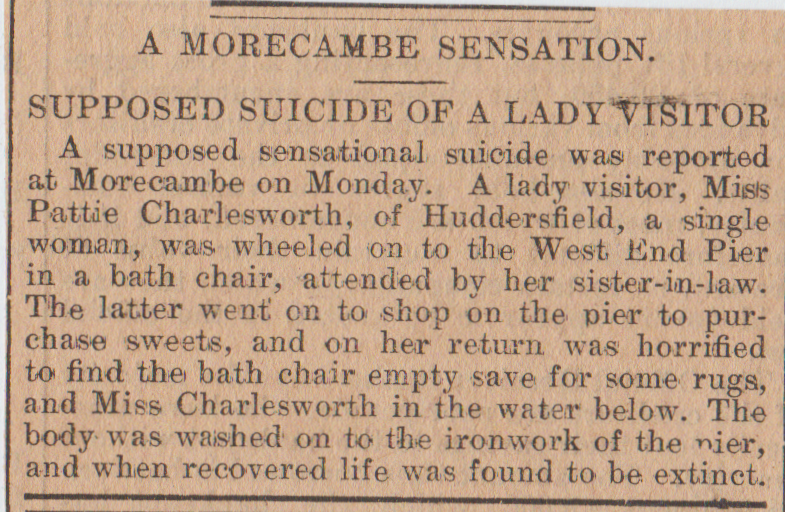Lancaster County Asylum Suicides
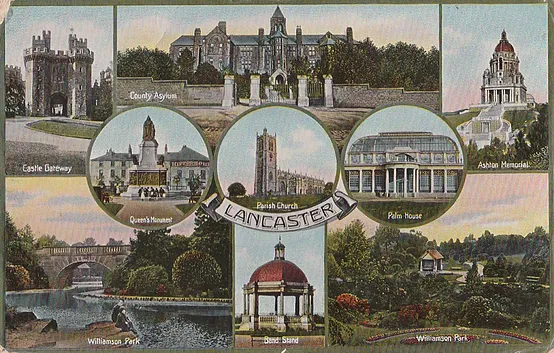
1/ May 1905
A patient was left to bathe for a couple of minutes when a clutch of inmates decided to help out. They decided to use boiling water! The patient died from scalding.
2/ September 1895
As you can see from the above postcard, (top pic) Lancaster County Asylum is an imposing building. A native of Liverpool, Nathaniel Taggart decided to commit suicide by jumping from one of the windows.
3/ March 1907
Sarah Ann Buss aged thirty-eight, became a patient here because she was a suicide risk. Part of the nurse’s training was to keep bathroom doors locked and don’t leave them alone. One nurse wanted a quick soak herself and filled the bath and then went for a cup of tea. Not the best idea! Sarah sneaked in and was found on her return with skin burns and scalding. The coroner was very scathing about the lack of a system that staff could follow, but no blame was attached to the nurse.
4/ Kirkham Triple Murder, near Preston, May 1886
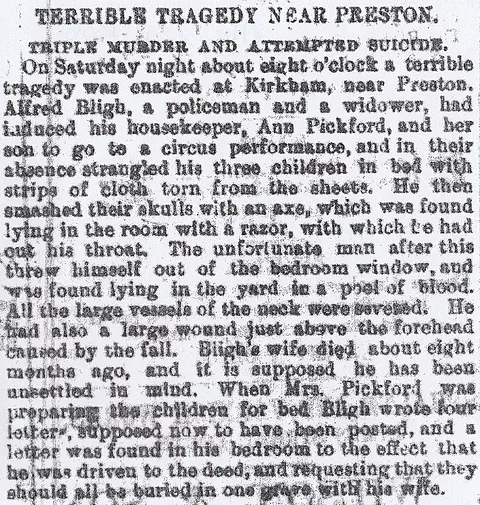
5/ Blackpool Tower Tragedy, February 1897
A painter was going about his business, over three hundred feet up Blackpool Tower when he got wedged in the moving balance-weights that operate the lift. One of his legs and an arm was torn off by the machinery and both he and another workman, by the name of Makinson, almost fell to the pavement below, but another painter grabbed hold of them and prevented certain death. (Did he die? Who was he?)
6/ Upholland Haunted House, August 1904
The haunted house is a four-storey building overlooking the churchyard and the supposed ghost has been the subject of an inquisition on the part of three members of the council. Strange noises are heard at night in a certain bedroom and when a light is shone to find out what it is, it ceases, then when dark again it carries on. Plaster is ripped from the walls, stones are wrenched from their setting and paper is torn from the plaster and strewn all over. The mother of the family who lives there has not slept properly in a fortnight. One of the councillors who stayed in the building had a stone thrown at him and when he tried to remove the paper from the wall, he had to use a pen-knife to gouge a tiny piece off. When it went dark, the paper had been ripped to shreds. The stones that moved are unable to be lifted by one man and the whole scenario is a freaky one. (The house that used to be next to the White Lion became known as the “Ghost House”. It was demolished in 1927 and parts of it were found to be of ancient origin)
7/ Rawtenstall Fatal Explosion, April 1899
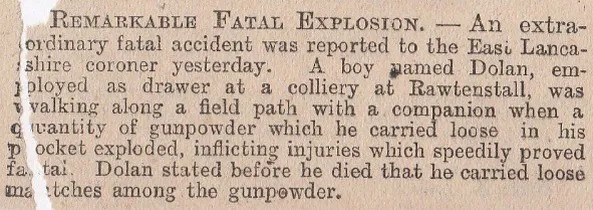
8/ Croston Church Suicide, near Preston, January 1903
An amazing act of suicide in a parish church took place in the village of Croston near Preston. Thomas Nelson, the 66-year-old sexton of Croston parish church left home to go and ring the six o’clock bell. The bell wasn’t heard, so his daughter went to see if he was all right and when she searched the church for him, she saw him hanging from a bell rope. He had of late been drinking very heavily and this may be partly the cause of why he did this.
9/ Poulton/Cleveleys Fatality, July 1885
A fatal accident occurred on Thursday night between Poulton and Cleveleys on the Fleetwood line. Thomas Etherington, a foreman platelayer, was at work on the line when a goods train from Fleetwood came along. He stepped on the downline just as a passenger train came round the curve and he was knocked down and instantly killed.
10/ Leyland, (Fatal Quarrel) April 1889

11/ Pleasington near Blackburn, (Decomposing Body Found) April 1875
A group of mason were walking in Alum Scar Wood, Pleasington when they found a body of a dead man in the stream that passes through the wood. It was in a bad state of decomposition, was partly naked and had been covered in leaves, that had fallen from the trees. An approximate guess of the length of time he’d been lying here, was several months. When they tried to lift out the body, it fell apart and innards dropped out. The clothing found nearby had two and a half pence in his pocket, no form of identity and a comb and a brass handle from a knife.
12/ Chorley Suicide, April 1885
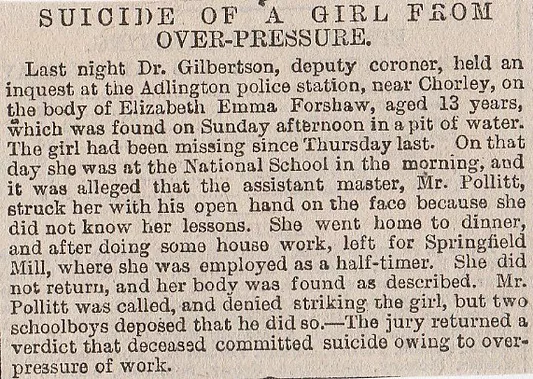
13/ Lytham St Annes Golf Club Suicide, April 1908
At about seven on Sunday evening, Dr Muggleston from Lytham found the body of Oscar Baron from Rochdale, in the lavatory at the Dormy House, the residential part of Lytham and St Annes Golf Club. He had come for the weekend for a bit of golf but he ended up slitting his throat with a razor in the lavatory area. He was involved in a cotton waste business and he lived in Crimble Hall, Summercastle, near Rochdale, but for the past few days, he had been in a strange mood.
14/ Garstang Drowning, September 1906
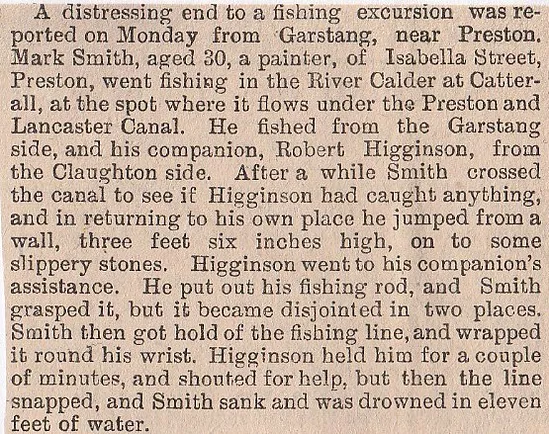
15/ Burnley Murder/Suicide, April 1893
Eli Eastwood, a fish hawker, was found drowned in the canal at Burnley and the woman who he lived with was found murdered. Elizabeth Longstaffe was a middle-aged woman and her body and head had been viciously battered in with a poker, which was near the body and was covered in blood and hair. Not only would these wounds have killed her but he had cut her throat with a razor as well.
16/ Backamoor Church near Blackburn, (Buried Alive) August 1902
A 23-year-old labourer named Haworth was busy digging a hole twelve-foot deep at Backamoor Church near Blackburn, when the sides caved in and he was buried under a huge pile of earth. When somebody finally found him, just the top of his head was visible. He was then hurriedly got out, but unfortunately, it was too late to help the poor fellow.
17/ Skelmersdale near Ormskirk, (Fell into Threshing Machine) September 1871
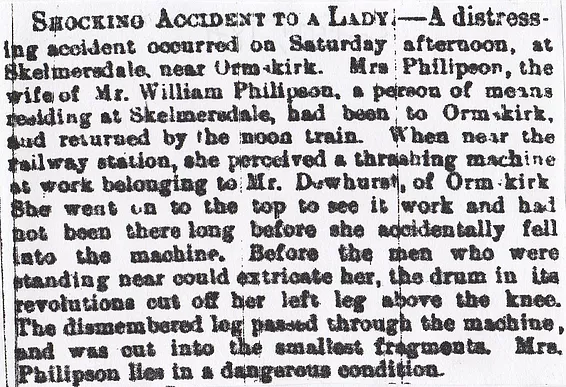
(Did she survive the accident or did she die?)
18/ Lathom Bathing Fatality, July 1885
On Sunday, John Thomas Lawrence aged twenty who was a drawer in a colliery, went with three other men to bathe in a reservoir at Lathom. The deceased was the first to go into the water and when he had got about thirty yards from the side, a man named William Roughley called to him to mind the holes. Soon after that the deceased sank suddenly and did not come into sight again. The body was recovered in about an hour.
19/ River Lune Drownings, September 1885
On Saturday night two men named Edward Coke of Lancaster and Frank Harrison of Plymouth were crossing the river Lune, which was much swollen by rain when their boat was struck by a heavy wave and upset and both men were drowned.
20/ Burnley Tram Accident, September 1885
Last evening a boy named Randolph Boys aged seven years, was run over and killed by a tram engine on the Burnley and District Tramways in one of the principal thoroughfares of Burnley. He had just left school and was watching some sheep being driven along the streets when the accident happened.
21/ Habergham near Burnley, (Child Cruelty) June 1885
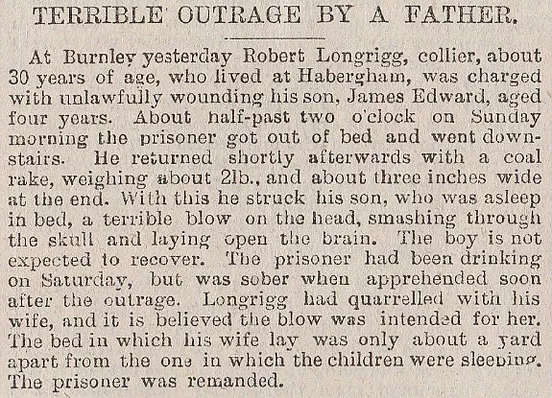
22/ Nelson Drowning, May 1891
At an athletics meet at Nelson in Lancashire, a crowd of thousands had flocked to see the athletes at various events. While this took place, the body of a six-year-old boy named Rushton was discovered in the river next to the field where the event took place. The probable cause was that he drowned while desperately trying to get across the stream near the sports ground and he fell and drowned.
23/ Lytham Drowning, April 1899
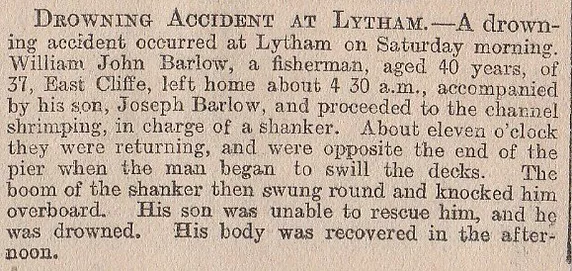
24/ Palace Music Hall Accident, Blackburn, August 1905
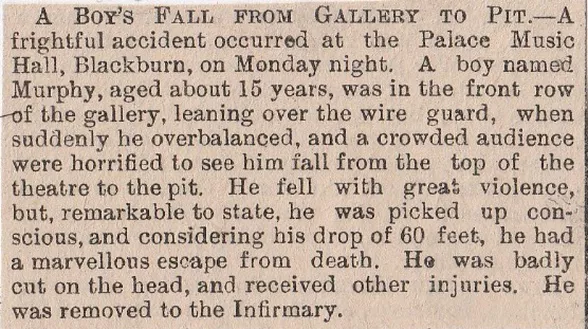
25/ Cottam near Preston, June 1849 (Murder/Suicide?)
The bodies of William Hull, a Preston bricklayer and Margaret Hull, his wife, were found in the canal at Cottam about three miles away from Preston. Hull had been under the influence of alcohol for a while and threatened to drown his missus. The how’s and why’s are just guesswork, but the verdict of “Found dead in the canal, appearing to have been drowned, but how they came into the canal there was no evidence to show”, was saying it was probably the husband killing the wife, then himself.
26/ Lancaster Barracks, (Soldier Strange Death) March 1885
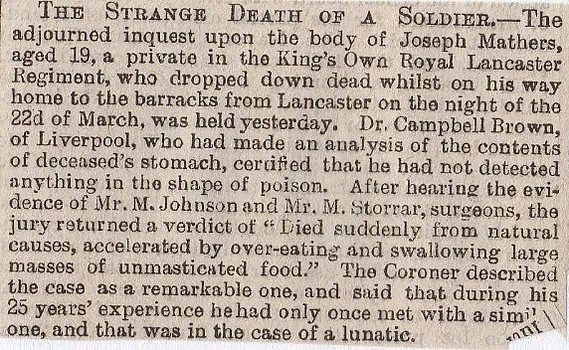
27/ Steamship “Fenella” January 1899
February 3rd, 1899- The inquest was concluded yesterday at Fleetwood upon the body of William F.Quayle, a Liverpool schoolmaster, who was one of the passengers washed overboard from the steamer “Fenella” during a passage from Liverpool to Douglas on January 2nd. The jury returned a verdict of accidentally drowned and recommended that the Isle of Man Packet Company should exercise more authority in compelling passengers to go below in case of danger.
Steamship “Fenella” March 9th, 1899
The body of J.F.White, one of three passengers washed overboard from the “Fenella” during her ill-fated passage from Liverpool to Fleetwood in January last, was found in the nets of a Fleetwood trawler yesterday morning and conveyed to that port.
28/ “Fenella” March 9th, 1899
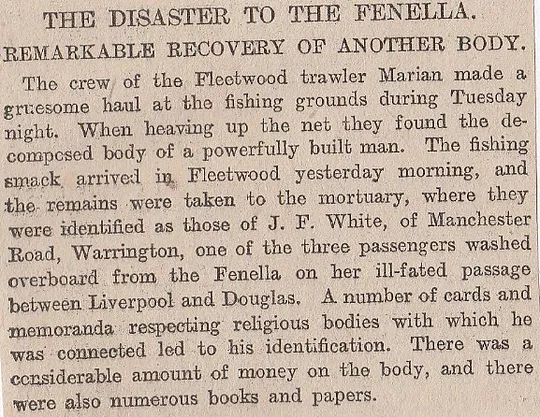
“Fenella” March 11th, 1899

29/ Garstang, September 1888 (Wife Murder)
The wife of a labourer named Neil from Garstang, suffered horrendous injuries at the hands of her husband. He punched her, jumped on her and threw heavy objects at her, then smashed a stool over her, smashed her head on the floor and finally tried to roast her before the fire. Today he’d probably get three months suspended sentence and a course in anger management, but he was arrested but the sentence is not known. (Anyone know?)
30/ Blackpool Swindler, August 1889
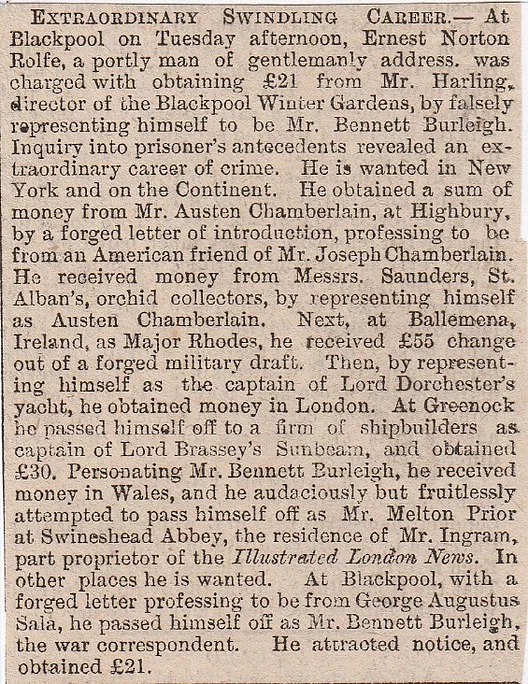
31/ Pendle Hotel Tragedy, Chatburn, June 1901
A Sunday school party of twenty girls from Accrington were in a coach driving to Downham. The coach stopped at the Pendle Hotel at Chatburn and whilst the driver was watering the horses they suddenly bolted and went down a steep hill, straight into the Post Office. Everyone was thrown out and seven were seriously injured, with two not expected to pull through. The force was such that the coach was smashed to atoms and both horses killed.(Anyone Die?/Pendle Hotel still there?)
32/ Blackpool Train Suicide, September 1859
A gentleman from Preston killed himself on the train due at Blackpool at 9-15 on Saturday night. Before getting to Poulton station, the passengers in the same carriage knew he had taken laudanum and was nearly unconscious as a result, but no one summoned medical help. When the train pulled into Blackpool he fell among the carriages but was lifted on the platform and he then made his way down the street, with a small crowd in tow. He was found leaning against some railings by a couple of fellas and was taken to the Railway Hotel but he died there almost straight away.
33/ Howick, (Boy Found Hanging) May 1885
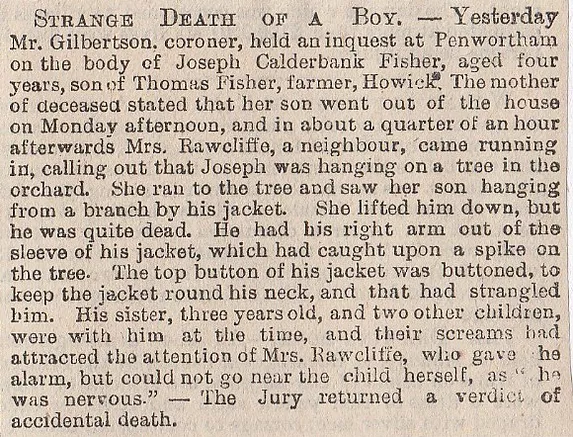
34/ Cliviger Railway Suicide, August 1885
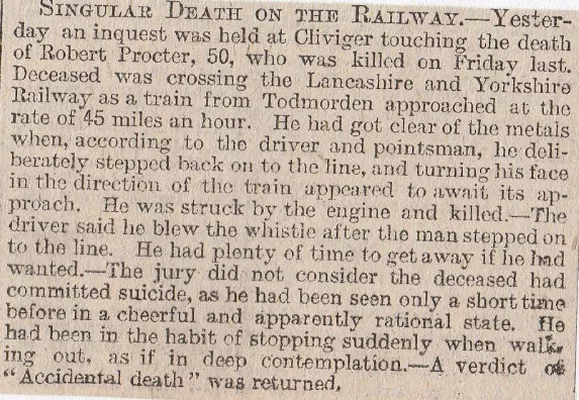
35/ Wesleyan Chapel Mass Hysteria, Bacup, October 1847
Mr Jackson, a well-known speaker on temperance was going to preach at the Wesleyan Chapel in front of about 1500 people. While the service was taking place, a rumour that the gallery had given way began to spread, then the inevitable mass hysteria and a mad panic for the exits. A woman and a young lad were trampled to death and another young man died the next day of his injuries. It was a case of the fastest and biggest treading on the weaker masses to get out, where little children were bruised and girls dresses torn and hats, shawls and shoes were left in the melee. The death toll was three, but there are another two in a critical condition and were not expected to pull through.
The true cause for the alarm was a pipe from a stove came out of the wall and made a funny noise. It was a sort of knocking sound and some women thought the props had given way in the chapel. The chapel was examined for structural defects after the accident and it was found to be safe and sound. (How many died? Is the chapel still there?)
36/ Preston Bicycle Death, March 1899

37/ Preston, (Fatal Accident) April 1899
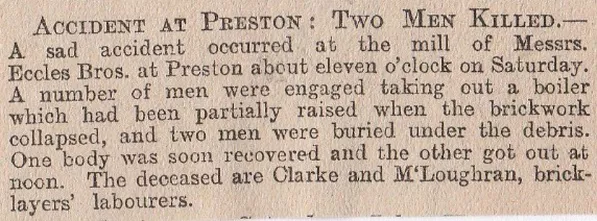
38/ Preston, (Fairground Death) May 1899
During a fair at Preston, George Slater aged fifty-three, an engine tester of Skeffington Road in Preston, went on the steam roundabout called the “Cocks and Hens”. Just as it was slowing up, Slater fell off, alighting on the back of his head. He was picked up unconscious with a terrible wound on the back of his head and was removed to the infirmary, where he died shortly after admission.
39/ Chorley Murder, August 18th, 1885

Chorley Murder, August 22nd, 1885
Alfred Holbrooks and Andrew Goldsberry were charged at Chorley yesterday with the murder of James Fallow. According to the evidence, the deceased and a man named Corrigan were molesting two youths and the prisoners interfered. Fallow was knocked down and kicked in the head and neck by the accused. Both prisoners were committed to the capital charge to the Manchester Assizes.
Chorley Murder, November 9th, 1885

40/ Dutton Manor near Blackburn, February 1918
The death of a beloved family pet dog caused the depression of Mrs Margaret Dugdale, the wife of Norman Dugdale J.P., of Dutton Manor near Blackburn. The dog had been put down, due to old age and she had become inconsolable ever since.
41/ Burnley Child Murder, May 1900
Dennis O’Hara, a labourer, handed himself in at a police station at Burnley on a charge of killing his six-year-old daughter. O’Hara had been separated from his wife for six months and he’d taken to the bottle as a result. She was seen leaving Sunday school near his house and was found, later on, strangled in a chair, with a rope around her neck. The neighbours had neither seen nor heard a thing.
42/ Warmden near Accrington, (Frozen to Death) January 1890
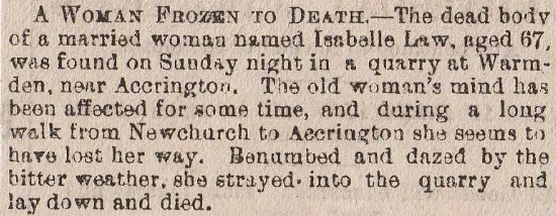
43/ Chorley Railway Station Fatality, September 1885
Yesterday morning, in the goods yard at Chorley Railway Station, John Jones, yard man, was assisting in shunting operations when he was run over and killed.
44/ Chorley Suicide? August 1904
Colonel Henry Darlington was discovered in the garden of his home, Birkacre House near Chorley. His head was blown to bits and in between his legs was a double-barrelled shotgun. The Colonel was head of a firm of solicitors, Darlington and Sons in Wigan, and he commanded the 1st Battalion of the Manchester Regiment. At first glimpse, it would seem to be suicide but it was deemed to be accidental. (Birkacre House still there?)
45/ River Lune, Lancaster, (Drowning) August 1873
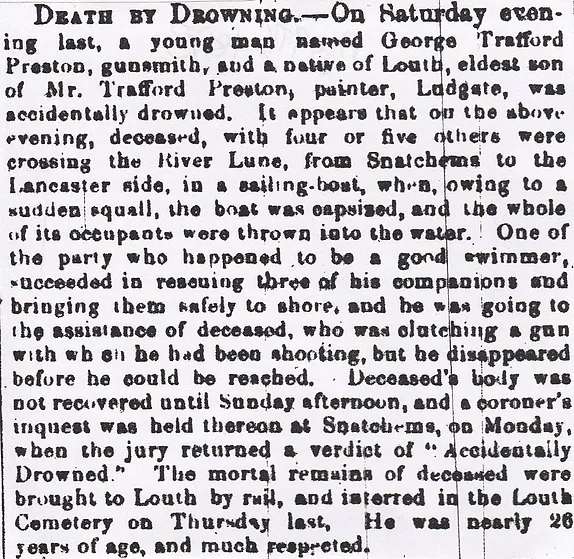
46/ Preston Murder/Suicide, September 1904
This story is one of a publican named Arthur Aston, who ran the Old Legs of Man Hotel in Fishergate, and his attempt to shoot his wife, then kill himself. One evening, Mrs Aston went to a friend’s, by the name of Roberts and was joined there later by her husband. Aston asked Mrs Roberts to go and buy something for him and when she came back, she found them both lying in a pool of blood in her kitchen. Mrs Aston had gunshot wounds to her face and above her right eye, but she was still alive. Mr Aston had a bullet in his head and the revolver he had in his hand had three chambers discharged. He is currently at death’s door and she is critical, but she uttered the words “He did it”. Jealousy is the motive.
47/ Poulton Suicide, August 1889
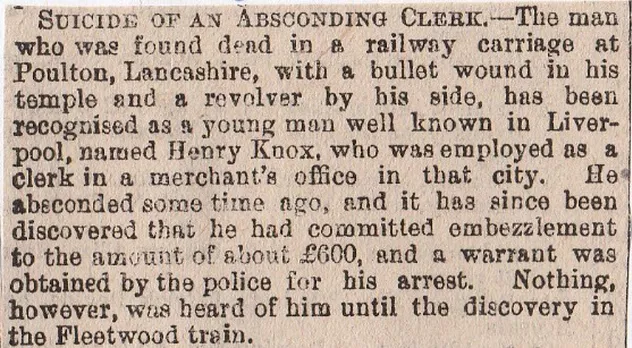
48/ Clitheroe Child Murder, May 23rd, 1885
At Bolton-by-Bowland Police Court yesterday, Grace Isherwood aged twenty-six, wife of John Isherwood, a farmer from Newton and Isabella Gardiner, her sister aged eighteen who was a domestic servant of Dalton-in-Furness, were charged with the wilful murder of Thomas Gardiner aged two years, the son of the prisoner Isherwood, by drowning him in a brook.
Clitheroe Child Murder, May 29th, 1885
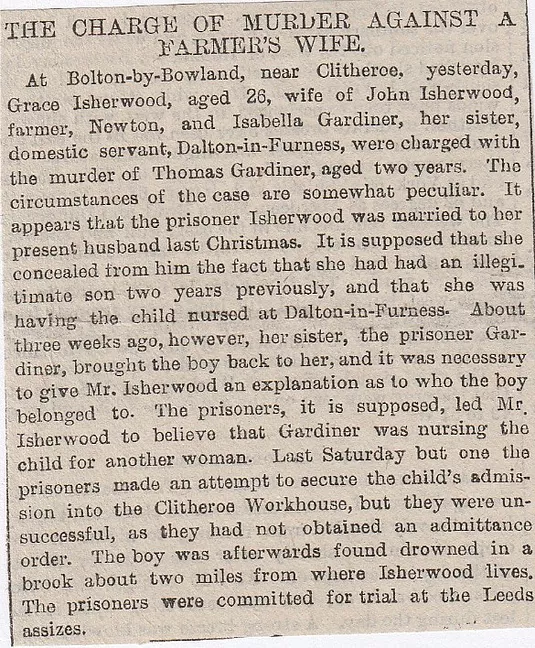
Clitheroe Child Murder, August 5th, 1885
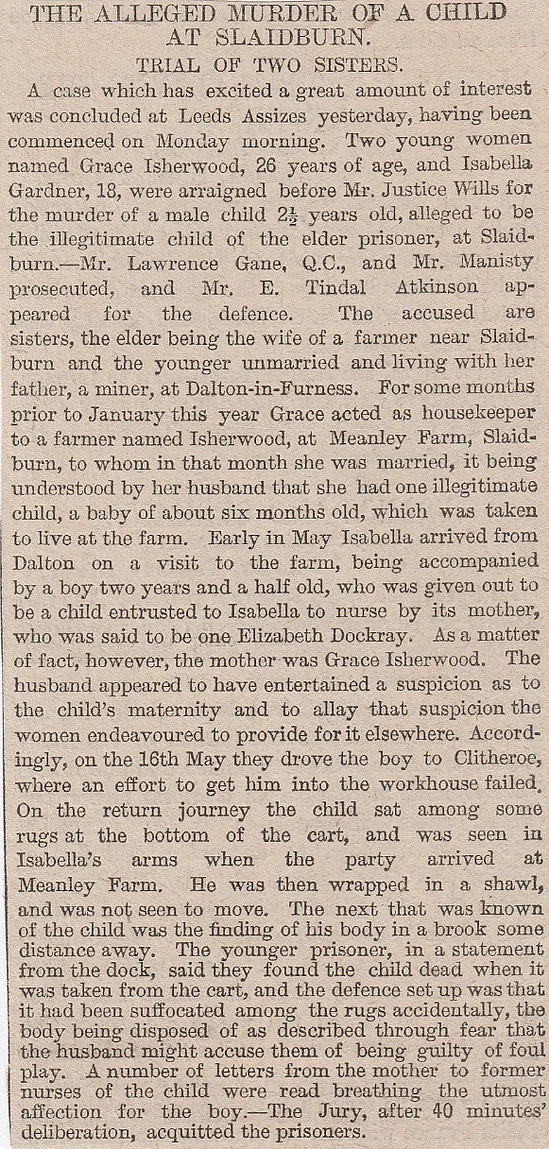
49/ Blackpool, (Killed by Lions) August 1905
A butcher who worked for the Blackpool Tower Co. found two lionesses and a lion cub wandering about the Aquarium Yard, Lytham Road at Blackpool. He had gone to feed them and they were in the yard and the other in the lion-house and rather bravely he got two back in their house. Both he and Mr Walmsley got them all into the cages, but a horrendous discovery was made when they trying to find out how they escaped. On the floor lay William Livesey, a carter who worked for the Tower Company. He was nude and ripped to shreds, his left leg was dislocated and portions of the body had been eaten away. His back and chest had deep claw marks. A witness by the name of Beck, saw Livesey and another bloke go towards the lion-house and a man was seen running away. It is thought that alcohol played a major part in the stupid act of going into the lion-house.
50/ Ormskirk Suicide, June 1879
52-year-old William Meadows, a rather eccentric gentleman as described by those who knew him, had declined any offers of work recently. He spoke to no other person than his niece and he would stay upstairs for days at a time and come down for food when no one was about. He hadn’t been seen for a couple of days, so a forced entry was made into his room and he was found hanging from the bed-post. A verdict of “Suicide whilst under temporary insanity” was returned.
51/ Preston, (Set Woman on Fire) December 7th, 1885

Preston December 8th, 1885
Archibald Titterington, a spinner was charged with having caused the death of Louisa Walsh of 3, Simpson’s Brow. The prisoner, who is a married man, went into Walsh’s house with her on Saturday night the 28th ult. and had some words with her. He threw a lighted candle at her and it set her cap on fire. The flames took hold of her clothing and she ran into the street screaming. Some men extinguished the flames and she was taken to the Infirmary. She lingered until Sunday evening when she died. The prisoner was remanded.
Preston December 9th, 1885

52/ Blackburn Haunted House, May 1908
A series of bizarre things have been happening at a workman’s house in Blackburn. Nineteen items, including vases and ornaments, had been flung about in rooms where the family were seated. It sounds like poltergeist activity. Even a couple of clocks have stopped for a few days in succession at noon exactly. The owner visited Lancaster a few days back, learned that two of his relatives had died within a week of each other and then the poltergeist activity stopped on the day of the second relative’s funeral.
53/ Burnley Murder, February 3rd, 1899
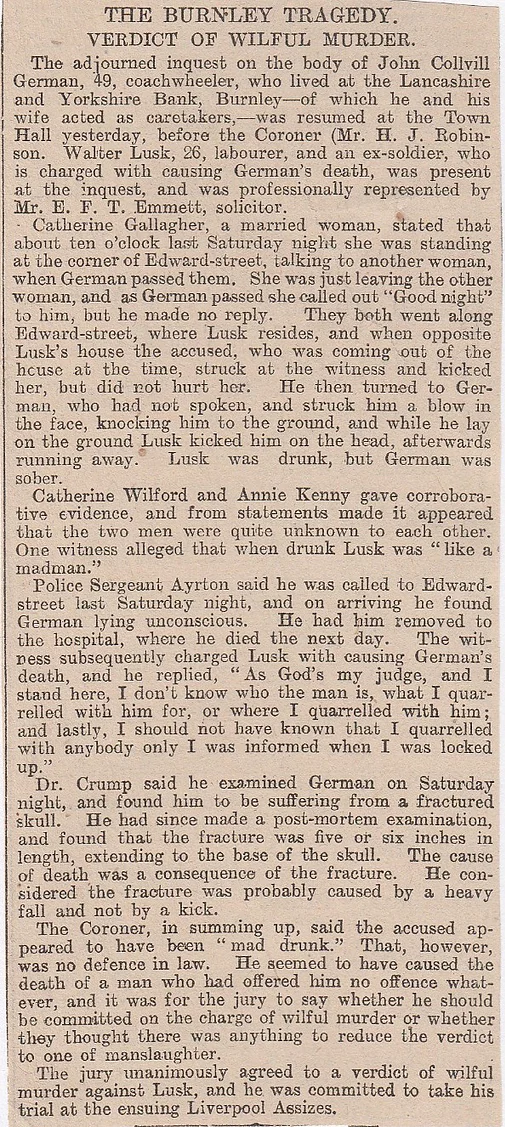
Burnley Murder, February 8th, 1899
Walter Lusk, an ex-soldier, was charged with the murder of John Colwill German, a coach wheeler, on Saturday night week. German was walking along Edward Street when Lusk, who was drunk, came out of his house and knocked him down and kicked him. German was taken to the hospital but died the next day, his skull being badly fractured. The prisoner was committed to Liverpool Assizes.
54/ Nelson Fatal Quarrel, December 1885
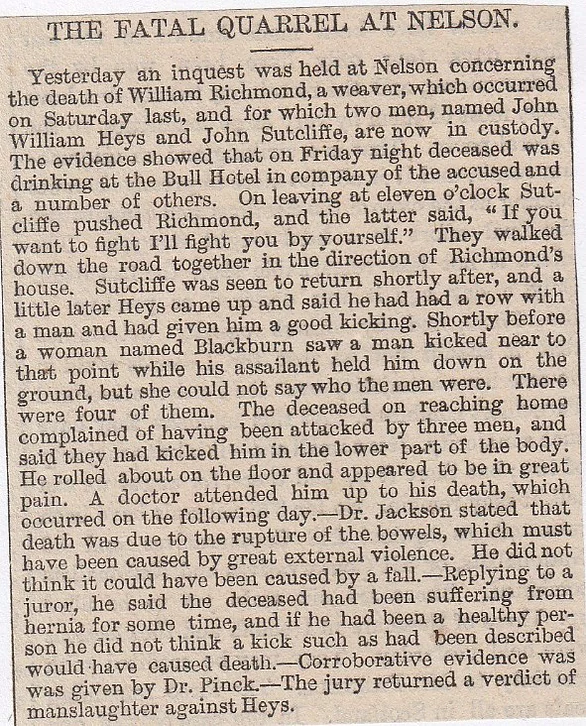
55/ Whalley Abbey near Blackburn, (Corpse Found) January 1889
A dead body of a man was discovered in a room of an old tower at the entrance to the Abbey grounds. He had on him a membership card for the Caulker’s Association and had the name “Francis Chedley, St John’s”. It is thought he is a United States sailor, as there was also a card from the United States Hotel, Liverpool on him. The post-mortem suggests he’d been dead for a week or so and was in his mid-forties. Apart from this small collection of clues, there is little else to go on.
56/ Preston Suicide, January 1877
Elizabeth Blezard, a 19-year-old reeler, was found in the Fishwick Mill Lodge at Preston. She was seen the previous night but was found only a matter of hours later, the next morning. A letter on her contained these curious words:
“A talken that I did for love, there shall be seen a milk-white dove, which o’er my watery grave shall fly, tis their you find my body lie. His words are pledged into me, he never may prosper nor happy be, farewell vain world, false Jim adieu, I drown myself for the love of you. This tie that I have round my neck, I hope to carry to my grave. Farewell dear Rachael, who I always loved, I pray for thee in Heaven above.”
The “false Jim” mentioned is the lad she seeing at the time but who became engaged to another girl. “Rachael” was a companion of Elizabeth’s.
57/ Blackpool, (Athletics Death) February 1895

58/ Leeds Liverpool Canal Suicide, Nelson, March 1892
An inquest was held at Brierfield near Nelson on Monday, touching the death of fourteen-year-old, Josiah Hartley, whose body was found in the Leeds Liverpool Canal on Sunday. On March the 3rd he was summarily dismissed from his job as a cotton weaver and this caused depression of spirits. He committed suicide the same day.
59/ Leeds Liverpool Canal Fatality, Burnley, May 1899
A fatal bathing accident occurred yesterday at the Leeds Liverpool Canal at Burnley, the victim being Alfred Varley, a labourer who was employed at the Mitre Timber Works. Varley and other workmen were bathing in their dinner hour when Varley was missed. Search was made but he could not be found. Police dragged the canal and found the body, which was taken to the mortuary. Varley was only nineteen-years-old.
60/ Leeds Liverpool Canal (Child Death), Burnley, June 1899
Frederick William Dewar aged five, residing with his parents at Milner Street in Burnley, was playing with some friends on the banks of the canal on Thursday when he accidentally fell into the water. It was some time before assistance was forthcoming and the body recovered. Artificial respiration was resorted to without avail.
61/ Walton near Preston, (Body Found in Woods) September 1882
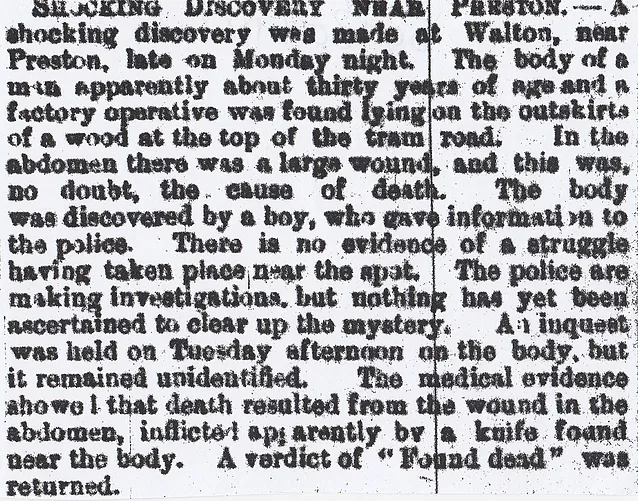
62/ Lowerhouse Lodge, Burnley, (Bathing Fatality) June 1899

63/ Newchurch near Bacup, (Suicide and Murder) May 1886
Two sisters named Jackson were found drowned in a mill lodge at Newchurch near Bacup. The older sister who lived at Bacup had just got two weeks notice to leave her job at Oakenclough Mill where she was employed as a weaver. She went to Newchurch to see her sister and they were seen together, walking past the mill lodge where they were found. They were discovered the next morning, with a message left on the bank, saying that they intended to commit suicide. An uncle told police of an incident a few months ago that the elder sister had threatened to drown the younger after a quarrel they had. The verdict was that: “The elder sister had committed suicide whilst of unsound mind and the younger was found drowned, but there was no evidence to show how she got into the water.
64/ Lytham St Annes, (Lady’s Suicide) August 1885

65/ Talbot Inn, Lytham, (Strange Death) April 1885
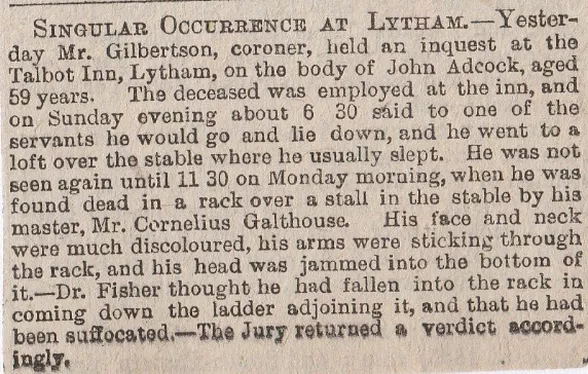
66/ River Ribble, Preston, (Accident or Suicide?) July 1881
Hugh Doherty from Walton near Preston, who should have been wed on Saturday, committed suicide. He had been out with some mates and on the journey home, they passed the River Ribble, which was in full flood. He shouted “Goodbye” and tried to jump over the railings but a mate of his grabbed him and there was a scuffle and Doherty escaped and dived into the river. He was swept away at a fair pace and was probably taken out to sea by the fast-flowing current. The body was not found.
67/ Bastwell Murder, near Blackburn, March 1876
Portions of the body of a teenage girl without head or limbs, which was wrapped in newspaper, were discovered in a field in the village of Bastwell near Blackburn. Later information came about that the body was that of Emily Holland, a local girl. William Fish has confessed to her murder and to chopping her up and dispersing the remains.
68/ Fleetwood, (Freak Death) February 1885

69/ Fleetwood Fatal Accident, December 1885
Johannes Guedon, a Dutch sailor on board the steamer Paola at Fleetwood, was accidentally killed. The vessel was ready for sea and the deceased and another member of the crew was lifting the hatches, when Guedon fell backwards into the hold, a depth of eighteen feet. Medical assistance was obtained but his injuries were so serious that he died in an hour and a half.
70/ Fleetwood Station Death, February 1885
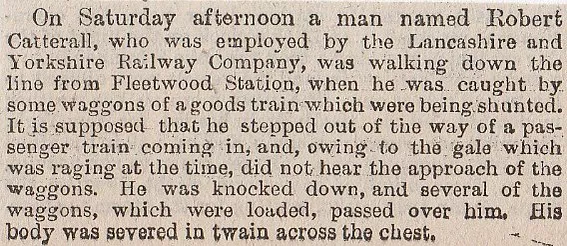
71/ Fulwood Barracks, Shooting, Preston, March 21st, 1885
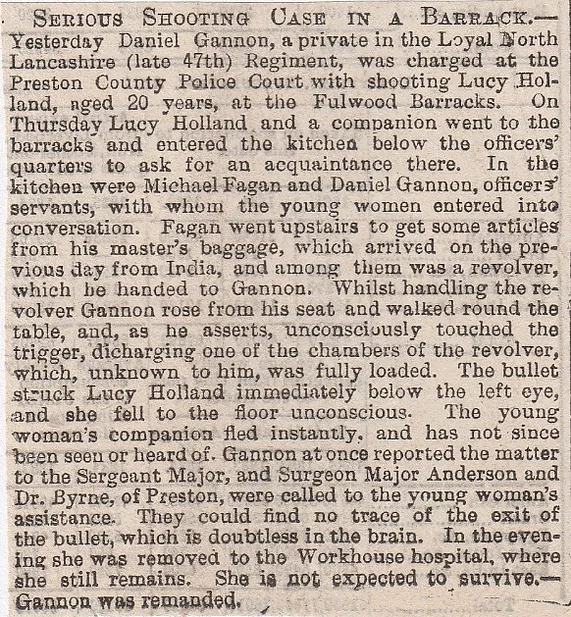
72/ Fulwood Barracks March 27th, 1885
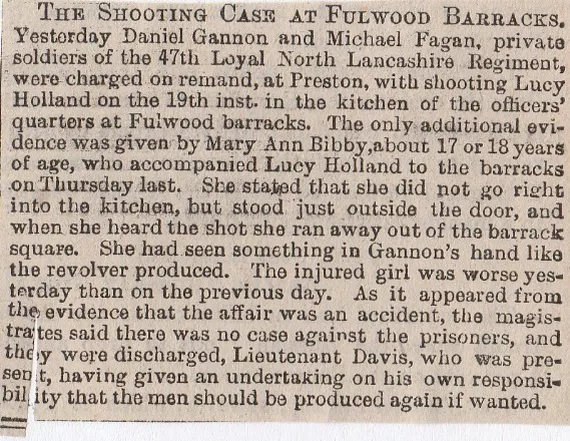
73/ Lancaster Soldier Suicide, July 1841
Peter Ormrod, a deserter from the 10th Regiment of Foot, went missing for seven weeks, AWOL. He was tried in a court-martial and sentenced to several months in prison. When he finished the sentence he left gaol with nothing and was unsure if the Regiment would take him back. He was forced to steal and was sentenced to a year in prison. After nine months had gone by, he kept saying that he’d rather kill himself than go back to the Regiment. The gaoler wrote to the colonel of the Regiment asking if they would take him back and the reply was”the prisoner would be claimed”. Ormrod kept his word and hung himself from the bars above his door.
74/ Preston, (Toy Cannon Suicide) May 1889
William McGregor aged sixty-three, killed himself in an extraordinary manner at Preston on Saturday. He placed a toy cannon on the top of a wringing machine and exploded it with a hot iron, with the charge blowing out his brains. The action was obviously premeditated.
75/ Blackburn Murder/Suicide, March 1892
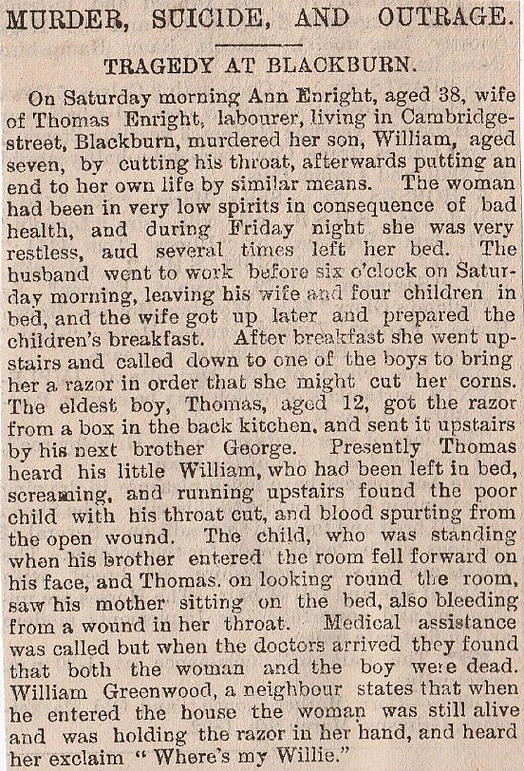
76/ Lytham St Annes, (Suicide Made Sure) January 1874
James Whiteside was a strange old character and was known locally as a bit of an eccentric. The 70-year-old was found hanging from a noose tied around a beam in his brother’s barn near Lytham. To fasten the rope he would have had to get on a scaffolding, then place his head in the noose and swing off. When found, his feet were a yard from the ground and he was cut down immediately. A policeman found a pistol in his pocket and it was loaded and ready to fire. Also was a knife, £10 in gold and other bits and bobs, but he had a Plan B and a Plan C just in case the others methods didn’t work.
77/ Blackburn Wife Murder, July 1889
At Blackburn on Monday, William Cox aged thirty-seven, a bolt maker, was charged with having caused the death of his wife. It is stated that early on Sunday morning he went to a neighbour’s house and asked a woman to go and look at his wife. She did so and found her lying dead on a mattress in a pool of blood. The woman had been kicked in the abdomen. Cox was remanded pending the inquest.
78/ St Annes -on-Sea (Lytham) June 1895 (Military Suicide)
Colour-Sergeant Aspin of the North Lancashire Militia, encamped at South Shore, St Annes-on-Sea, blew out his brains at five o’clock on Monday morning. He placed the muzzle and released the trigger with his toe. The men of the Company say that he had been low-spirited all the past week and scarcely able to drill them.
79/ Oswaldtwistle Suicide, November 1903 (Really Sad!) This is one of my “Favourites” if you can call them that. Would love to find out who she was or where she is buried.

80/ Clitheroe, (Cork Leg Gives Way) November 1896
Hannah Birch aged seventy-one of Hayhurst Street in Clitheroe, who wore a cork leg as the result of an accident eight years ago, slipped in going downstairs on Saturday through her artificial limb giving way. Her fall occasioned concussion of the spine, from which she died shortly afterwards.
81/ Blackburn, (Wrestling Death) August 1896
Robert Calverley, a Blackburn weaver, entered a public-house near his home on Saturday night and began to wrestle with another man. During the tussle, Calverley fell under his opponent and was so badly injured that he had to be carried home. Medical aid was summoned and it was found that his spinal cord had been ruptured. He died on Monday morning.
82/ Parbold Quarry Death, November 1896
The death is reported of Mr Thomas Taylor, quarry owner of Parbold near Wigan. While he was superintending the removal of some blocks of stone in the quarry, a large piece fell from the face of the cutting, killing him instantly.
83/ Blackpool Manslaughter, October 3rd, 1885
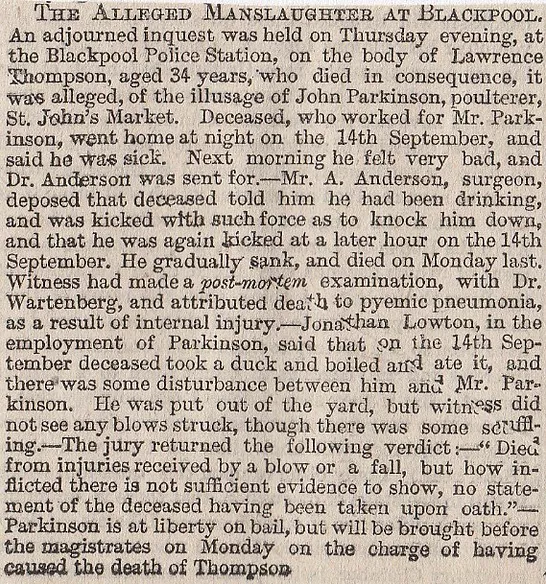
Blackpool Manslaughter, November 9th, 1885 (Continued from above)
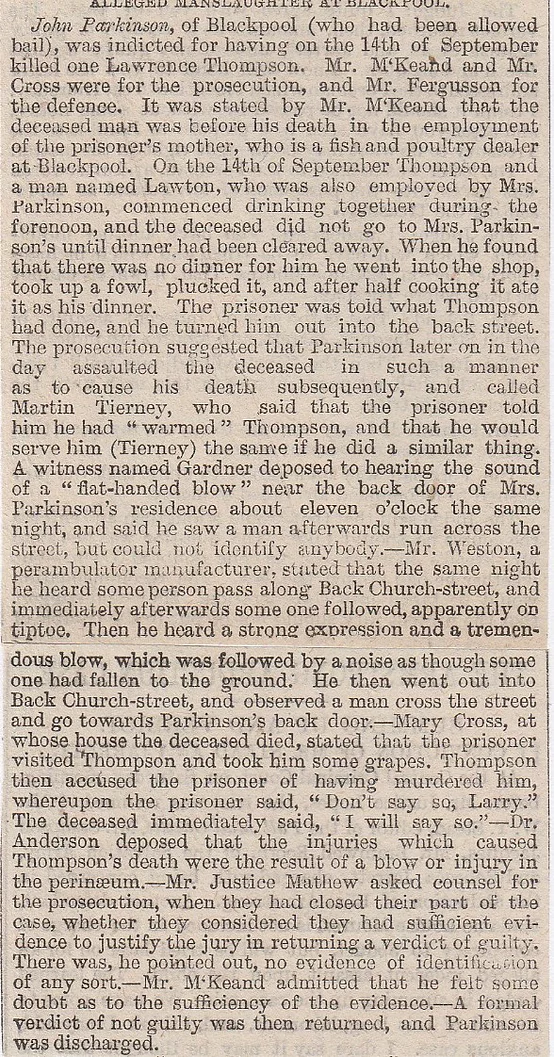
84/ Preston, (Boys Bury Lads Corpse) September 1890
The body of a young boy named Bunting who lived at Gordon Street in Preston was found after an amazing confession by two boys. Robert Pentowy and William Vickers said that last week, along with two other lads, they were messing about on the canal bank and got “larking” with a crane. Bunting grabbed the chain and three others swung him around, till he hung over the water. They all legged it, except Pentowy, who tried to bring him in again. After screaming to the others to help him Bunting fell in the canal. They all returned later on, and one of them brought his body to the canal side, then carried away, but being frightened of the repercussions they buried him behind some new houses off Brook Street. The body was recovered by a labourer a couple of days later. Police are investigating the matter.
85/ Burnley Bank Manager Suicide, May 1899
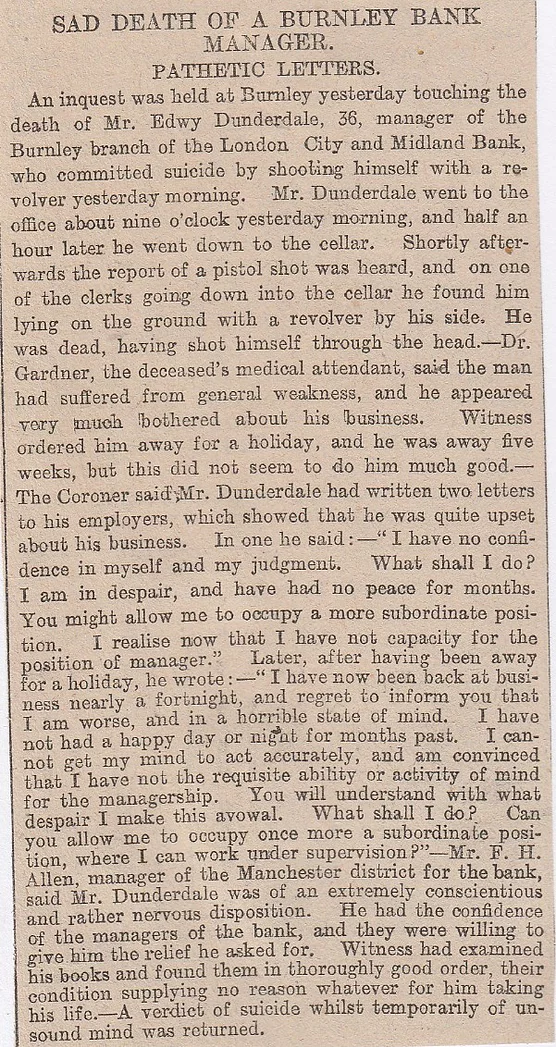
86/ Burnley Child Murder, March 1899
Martha Dixon aged nineteen, servant, was indicted for the murder of her child at Burnley on March 2nd last. It was alleged that immediately after the birth of the child the prisoner threw it into the canal, where it’s body was recovered a week later. The jury decided that the evidence was not sufficient to support the capital charge and found the prisoner guilty of concealment. She was sentenced to one month’s imprisonment.
87/ Burnley Murder/Suicide, May 1899 (Did she die?)

88/ Church Street Attempted Murder, Preston, April 1906
At a house in Church Street in Preston, a butcher by the name of Albert Dewhurst was stabbed in the chest by his wife. Albert left home at 7-15 a.m., but on returning for something he was met by his wife who had a knife in each hand. She flew at him and plunged the knife into his chest causing a small gash, but internal haemorrhaging caused his death a few minutes later. One witness said he threw up his arms and fell dead, while he was on his way out of the house to the market. The wife ran up to her bedroom and locked herself in her room. The police broke down the door and grabbed hold of her just as she was going to stab the daughter. (What happened to her?)
89/ Blackburn Mill Fire, February 20th, 1885

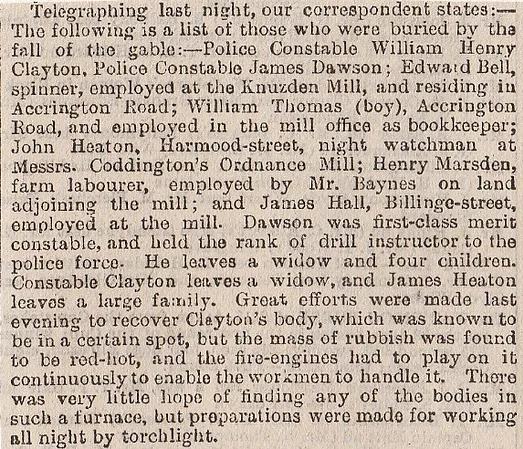
Blackburn Mill Fire, February 21st, 1885
Efforts were made throughout Thursday night and the whole of yesterday to recover the five bodies buried by a fall of a wall during the fire at Knuzden Mill near Blackburn. The task was rendered dangerous by the tottering condition of the burnt-out building and yesterday another large portion of the walls fell. Portions of one body, identified by scraps of clothing as that of James Hall, painter, were recovered but the search for the other bodies will have little result, as the material under which they are buried remains at a red heat. Fragments of human bones were found yesterday, but their identification is of course impossible.
Blackburn Mill Fire, February 23rd, 1885
The bodies of the seven persons who perished in the fire at Knuzden Brook Mill, Blackburn, have now been recovered from the ruins and identified. One of the side walls of the mill fell on Saturday and demolished a large weaving shed which, it was hoped, would have started very shortly. By this fresh accident, about 300 additional workpeople will be deprived of their employment.
90/ Anchorsholme Crossing Fatality, Fleetwood, August 1905
While cycling from Fleetwood to Blackpool, Thomas Rossall, a labourer from Great Eccleston, attempted to ride around an electric tramcar which was stationary at Anchorsholme Crossing. He was caught by another car proceeding in the direction of Blackpool, knocked down and pinned beneath the lifeguard. He received shocking injuries and died at Fleetwood Cottage Hospital.
91/ Avenham Park? Preston, (Boating Fatality) May 1905
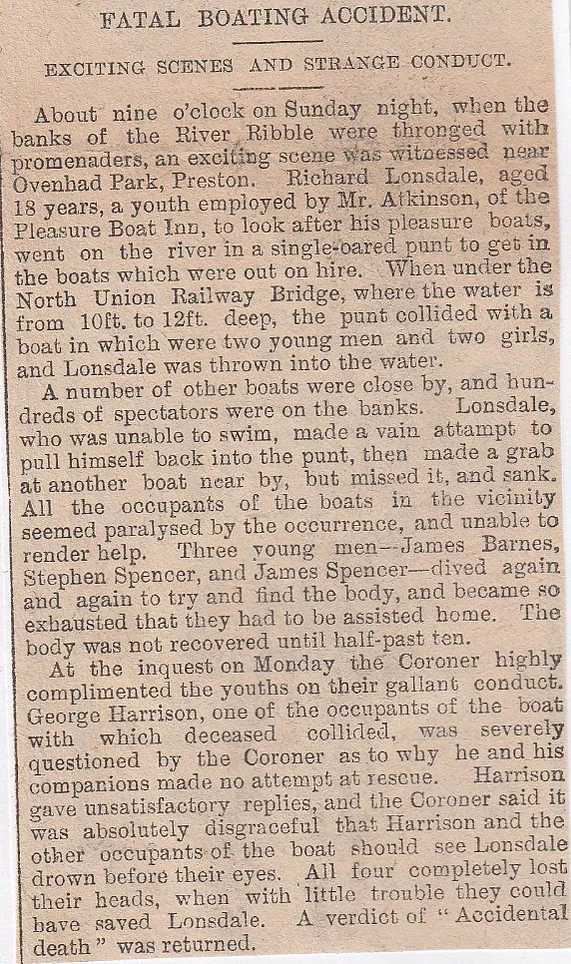
92/ Clayton-le-Wood Suicide, near Chorley, July 1868
The body of a man was found in a wood at Clayton-le-Wood, with a revolver in his hand and in an appalling state of decomposition. He had left some papers on his body to identify himself and it turns out it was William Henry Hately of Lymm near Chester. He was twenty-seven and had been to see his uncle in Chorley, when on the 18th June he went out, saying he’d be back soon, but never returned. The facial features are unrecognisable and it is being treated as a suicide.
93/ Preston Murder, June 1866

94/ Garstang, May 1901 (Wife Drowns Three Kids)
Mrs Simpson, a miller’s wife, residing at Sandholme Road Cottages, drowned her three children in a washing tub. Her husband left home to go to work and when he came back at ten o’clock that night he found his children had been drowned. The 26-year-old mother had done the dastardly deed in a dolly tub. The youngest was only eighteen months old, was still warm when found and the others aged four and five respectively, had been drowned earlier. They were all laid in bed and fully dressed. The wife was arrested and the husband is inconsolable at this time.
95/ Blackpool, (Fatal Trap accident) June 1885
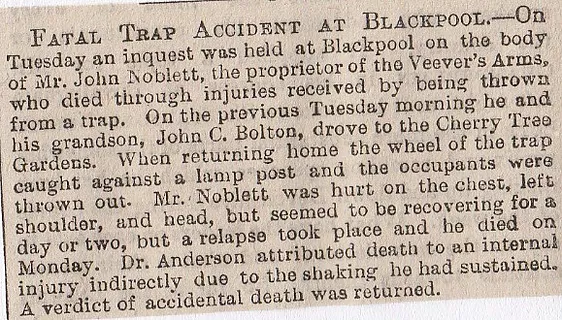
96/ Blackpool Cart Fatality, July 1885
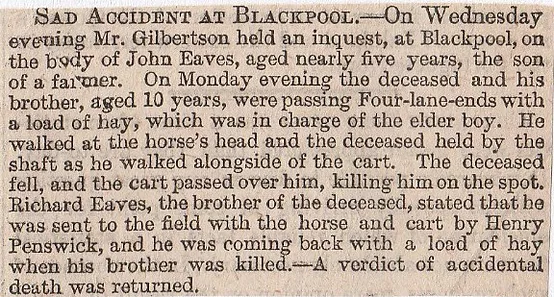
97/ Farington Family Murder, near Preston, April 1906
In a cottage near the church in Farington, lived Henry Catterall a 55-year-old labourer along with his wife and their 12-year-old daughter, Jane Ann. The daughter knocked on the door of a neighbour, Mrs Craven, at six a.m. and asked her to come and see her mother who was ill. Mrs Craven went a little later and knocked on the door, but got no reply. She then went to Mrs Maddock, another neighbour, and they went back together. While trying to gain entry a groan was heard and as they looked up to the bedroom they saw a girl’s face at the window, with blood gushing from her neck. They eventually broke in and found Catterall and his missus lying dead in the bedroom, the wife with several cuts and wounds and the husband with his throat slit from ear to ear. Jane Ann was still alive but died later on that evening. It is supposed that Catterall who had been depressed of late, had killed them then committed suicide.
98/ Lancaster County Asylum, (Two Suicides) April 1904

Gertrude Lumsden aged twenty-seven and from Manchester was admitted to the Asylum, and on the same night, she tried to kill herself twice, by suffocation. She shoved a stocking down her throat and tied some cloth round her neck. On the following morning, she leapt out of bed and grabbed a bottle, threw it on the floor, picked up a shard of glass and severed her jugular vein.
The second suicide was shortly after the first one and involved 26-year-old William Pearson. He and another patient, Thomas Hall, had an argument last week but no violence ensued. The next day while the attendants were busy, Hall attacked Pearson and gave him a fractured skull. The jury returned a verdict of “Wilful Murder” but the Coroner refused to accept it. He said there was no evidence against Hall so they changed it to “Deceased died as a result of a blow to the head, but how it was delivered is not known.”
99/ Blackburn, April 1885
John Edmundsen, an engineer at a large cotton mill in Blackburn was killed yesterday by the bursting of the engine cylinder, portions of which drove him through a window into the mill yard. The mill machinery was stopped by the accident.
100/ Blackburn Fire Death, December 1885
A fire broke out on Thursday in the dwelling house No 22, Pollard Street, Blackburn, occupied by John Booth, weaver, but it was soon extinguished. Booth and his wife were out but there were two children asleep in bed. One of them, a boy aged two, was taken out dead through suffocation; but the other, a boy of five years of age, was rescued.
101/ Blackburn Pub Murder, October 1885
An inquest was held at Blackburn touching the death of Richard Kellett aged thirty-one, a weaver. Last Saturday night when in a public-house, he was accused of having been in prison and a quarrel ensued when he was stabbed under the left eye by a labourer named William Boyle? with a pocket knife. He died from the effects of the wound on Thursday.
Blackburn Pub Murder, November 1885
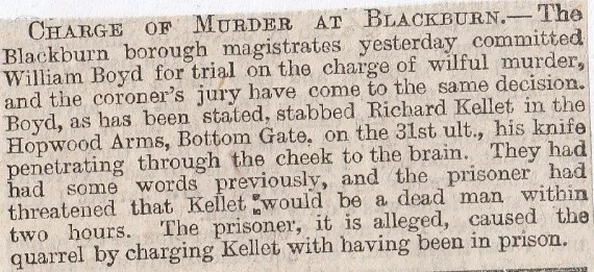
102/ Blackburn Fatal Argument, April 1885
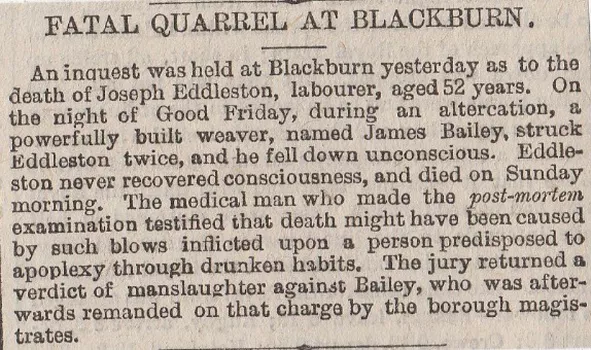
103/ Blackburn, (Sisters Fatal Quarrel) January 1885
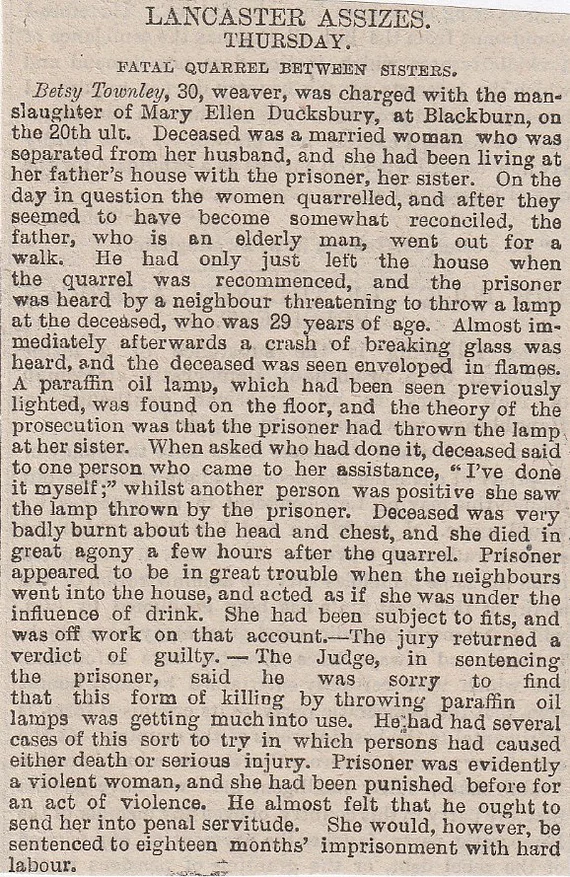
104/ Sir Walter Scott Pub, Preston, (Murdered on Wedding Day) August 1881
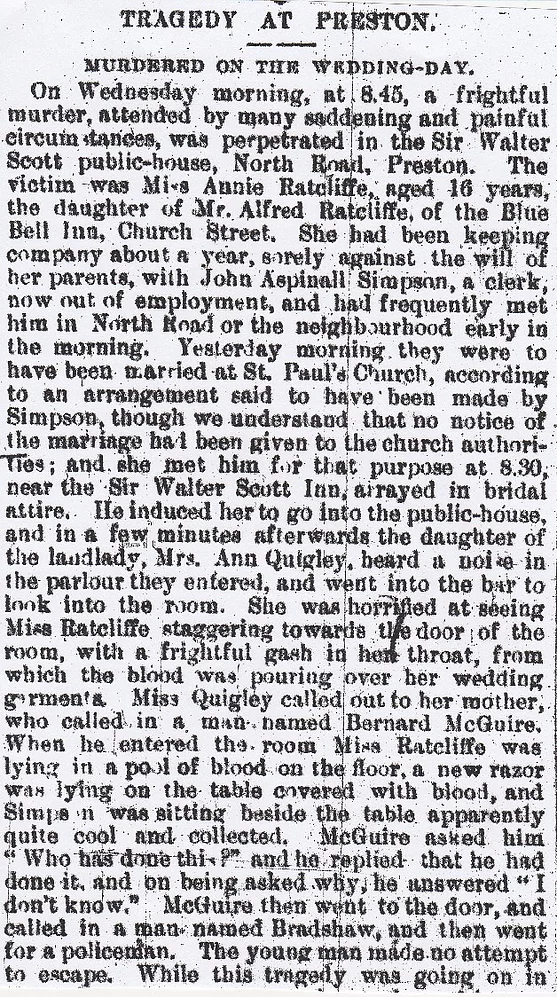
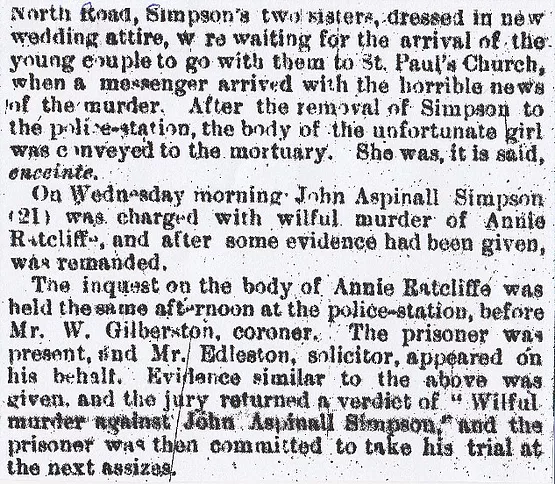
105/ River Ribble suicide, Preston, May 1885
At Preston yesterday there was taken from the Ribble, the body of a young woman, who appears to be about twenty-five years of age and who was respectably dressed in black. There were no marks of violence on the body and it is believed that the case is one of suicide.The body was removed and the facts reported to the coroner.
106/ River Ribble, Preston, July 1885
On Sunday afternoon, James Walsh, a piecer aged twenty-two, son of a widowed mother living in Adelphi Street in Preston, was drowned in the Ribble, opposite the new dock works. He went into the water with some other young men and having swum across, was returning to the Preston side when he cried out “I am done” and sank. It is supposed he was seized with cramp.
107/ Preston, (Cot Death?) August 1885
The body of an infant, three months old, the son of William Woan, spinner, was the subject of an inquest. The mother of the child said that on Saturday about midnight she went to look at the baby, which was in bed with her 3-year-old sister. She found the girl “lying on the child, her face close to its face” and as the baby did not stir she took it downstairs and found it was dead.-“Accidental Death”.
108/ Birley Arms, Newhall Lane, Preston, (Fatal Fire) November 1885
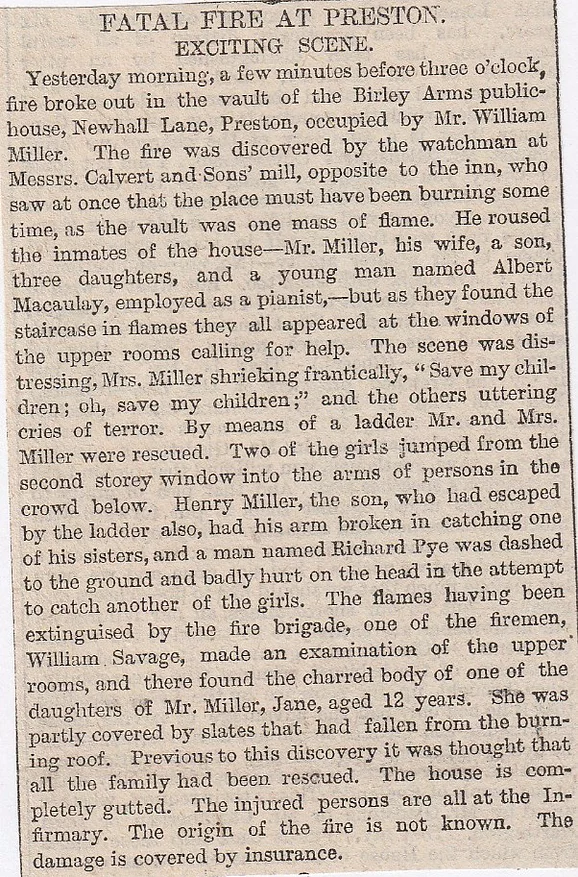
109/ Clarence Street, Marsh Lane, Preston, (Murderous Assault) November 1885
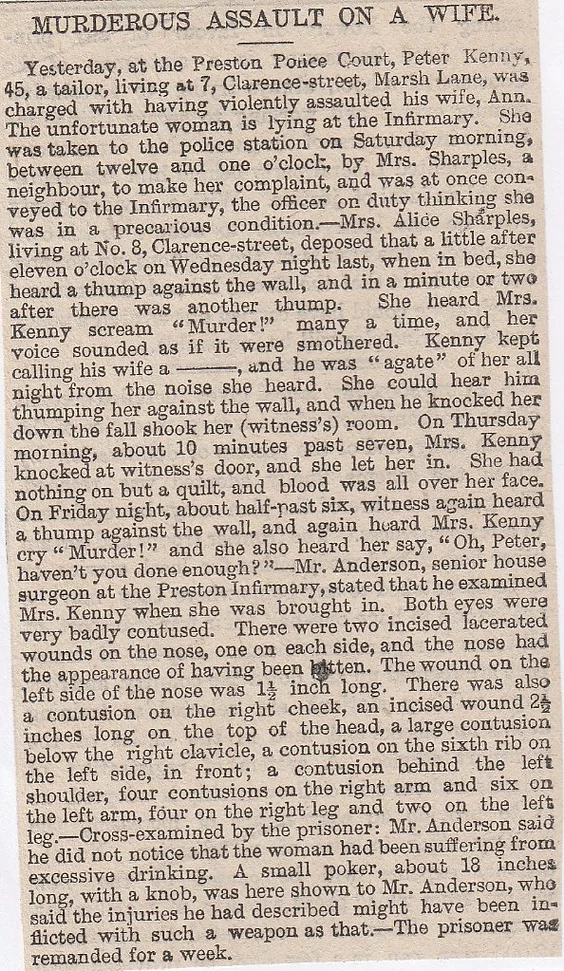
110/ Blackpool, (Body Discovered) April 1899
The body of a man who had been drowned was found on Saturday morning at South Shore, Blackpool. It has since been identified as that of Charles Fisher, a solicitors clerk aged twenty-six, of Blackburn, which town he left to go to Lytham on Friday. The body was fully clothed. How the man got into the water is a mystery. His relatives consider that a theory of suicide is out of the question.
111/ Blackpool, June 1899
A sad accident occurred yesterday to the only son of Mr Allen Clarke, a well-known Lancashire dialect writer, who lives in Blackpool. The boy went out fishing about 5-30 and fell into a pond. The alarm was raised by his companions and two men dived into the water, but they never found him. A drag was employed and the body got out. Mr Clarke is on a holiday ramble in Germany and Belgium.
112/ Royal Albert Pub, Blackburn, June 3rd, 1899

Royal Albert Pub, Blackburn, June 6th, 1899

113/ Blackburn Drowning, May 1899
A sad drowning accident occurred at Blackburn last evening. A lad of fourteen named William Southworth was bathing with a companion in the Leeds Liverpool Canal near the Bon Accord Mill, when his little brother on the bank saw him go under. His cries attracted attention but all efforts to recover the body were futile until the police got the grappling irons. It is supposed the lad was seized with cramp.
114/ Little Harwood near Blackburn, June 1899
Wilfred Parker Clarkson aged ten years drowned at Blackburn on Monday night. In company with another lad named Haworth, he was floating sticks in filter beds at Little Harwood, when Clarkson overbalanced and fell into the water. Haworth raised the alarm and some men by the aid of a clothes-prop got the lad out of the water, but though artificial respiration was resorted to, life was found to be extinct.
115/ Blackburn Drowning, June 1899
Robert Seed aged fifteen, a weaver, was drowned at Blackburn while bathing with his cousin, William Duxbury and three other boys. Duxbury went to the lad’s assistance when he saw him in difficulty. Seed caught hold of him and a desperate struggle ensued before Duxbury was able to free himself and swim to the side. The poor fellow’s body was recovered from seven feet of water.
116/ Blackburn, (Burned to Death) February 1899
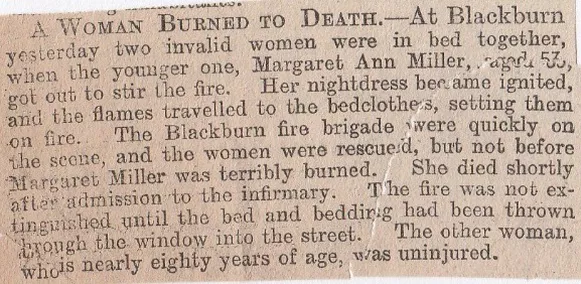
117/ Chorley, May 1899 (£50 for loss of son)

118/ Beach Hotel Suicide, Blackpool, July 1877
Everard J.Briggs, a twenty-eight-year-old clerk from Weaste, went to Blackpool for a short break. He checked into the hotel at eight o’clock, then went for a walk and put in an order for his breakfast next morning, and an alarm call at 7-30 a.m. The next morning, the boot boy, Reuben Cooper, was asked by Briggs what the time was, to which he replied: 6-45. Then later Cooper took the boots to his room and again he asked what time it was. This time it was 7-23. Later on at ten o’clock, since there had been no sign of him, they forced the door and found him on the floor in a pool of blood with a gun in his hand. It was later learned that he hadn’t been to work for three weeks and his mind seemed elsewhere.
119/ Blackburn Railway Accident (Two Dead) July 1870 (Says Plessington, but it should be Pleasington)
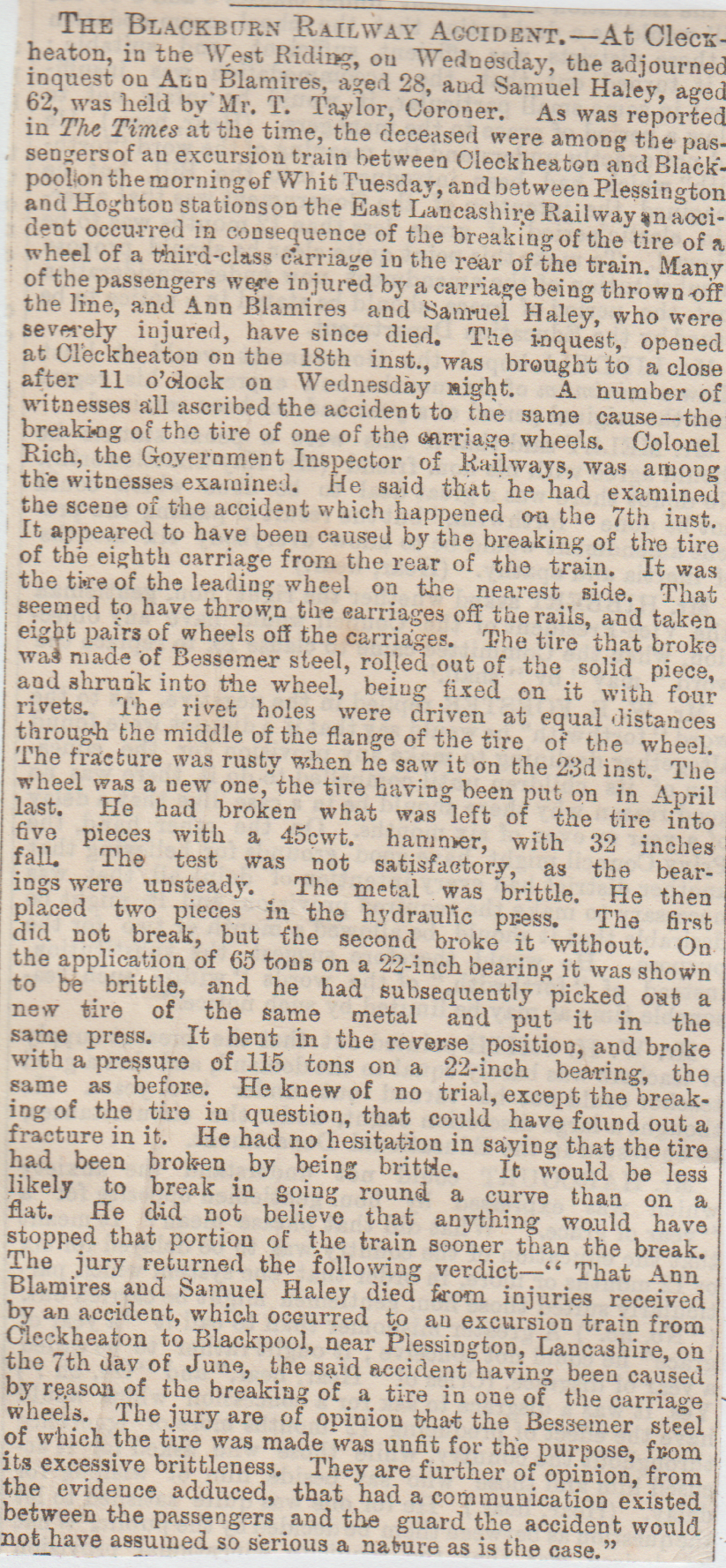
120/ River Ribble Drownings, Preston. October 1870
121/ Upholland Railway Death, December 1870
122/ West End Pier Suicide, Morecambe. February 1902.
